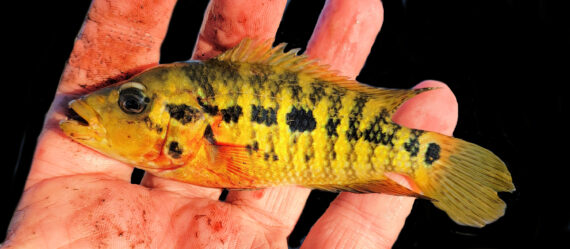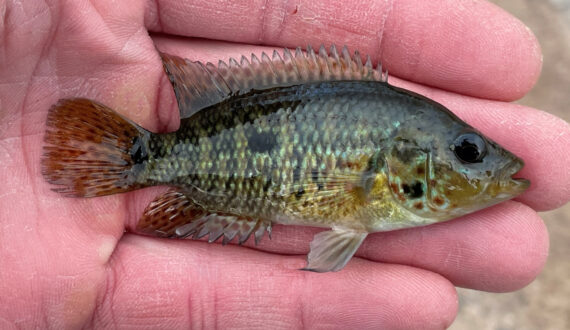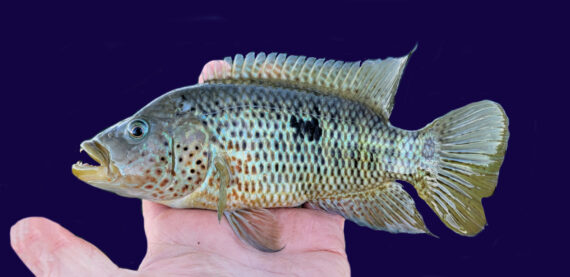False Yellowjacket Cichlid, Parachromis motaguensis
 False Yellowjacket Cichlid, Parachromis motaguensis, Female. Fish caught from a warm spring in rural Nevada, September 2022. Most likely a colony established from aquarium release. Length: 11 cm (4.3 inches). Catch, photograph, and identifications courtesy of Chris Moore, Peoria, Arizona.
False Yellowjacket Cichlid, Parachromis motaguensis, Female. Fish caught from a warm spring in rural Nevada, September 2022. Most likely a colony established from aquarium release. Length: 11 cm (4.3 inches). Catch, photograph, and identifications courtesy of Chris Moore, Peoria, Arizona.
 False Yellowjacket Cichlid, Parachromis motaguensis, Male. Fish caught from Fish caught from a freshwater pond within the Pahrump Valley, Nevada, November 2022. Catch, photograph and identification courtesy of Luke Ovgard, Klamath Falls, Oregon.
False Yellowjacket Cichlid, Parachromis motaguensis, Male. Fish caught from Fish caught from a freshwater pond within the Pahrump Valley, Nevada, November 2022. Catch, photograph and identification courtesy of Luke Ovgard, Klamath Falls, Oregon.
 False Yellowjacket Cichlid, Parachromis motaguensis, Male. Fish caught from a warm spring in rural Nevada, September 2022. Most likely a colony established from aquarium release. Length: 13 cm (5.1 inches). Catch, photograph, and identifications courtesy of Chris Moore, Peoria, Arizona.
False Yellowjacket Cichlid, Parachromis motaguensis, Male. Fish caught from a warm spring in rural Nevada, September 2022. Most likely a colony established from aquarium release. Length: 13 cm (5.1 inches). Catch, photograph, and identifications courtesy of Chris Moore, Peoria, Arizona.
 False Yellowjacket Cichlid, Parachromis motaguensis, Male.
False Yellowjacket Cichlid, Parachromis motaguensis, Male.
The False Yellowjacket Cichlid, Parachromis motaguensis, is a member of the Cichlid and Talapia or Cichlidae Family, that is known within the aquarium trade as the Red Tiger, Red Dragon Cichlid and Motagu Cichlid and in Mexico as mojarra del Motagua. Globally, there are five species in the genus Parachromis of which four are found in the streams, rivers, lakes, and ponds of Mexico’s freshwater systems.
The False Yellowjacket Cichlid has a sizable, robust heavy elongated body that is strongly compressed laterally with a depth that is 31% to 35% of standard length. They reach a maximum of 30 cm (12 inches) in length. They are sexually dimorphic with males being larger than females with more elongated and extended dorsal and ventral fins and slightly lighter in color. The False Yellowjacket Cichlid is the most colorful member of the guapote group. They have a series of bright red dots along the flanks of the caudal fin and highly colored gills. The males have a green color. The females are more brilliantly colored with deep shades of red and orange that becomes enhanced during breeding season.
The False Yellowjacket Cichlid is a freshwater benthopelagic species that is found in freshwater lakes and low velocity rivers which have rocky substrate with submerged logs that have water temperatures between 20oC (68oF) and 30oC (86oF). They have a large set of prominent teeth and are highly aggressive large predators that consume a wide variety of aquatic, terrestrial insects, and small fishes. Reproduction is oviparous, with an elaborate mating ritual, with each female laying up to 2,000 eggs in annual cycles. Populations are kept intact via cannibalization by the parents. The eggs are fertilized by the males and then both the eggs and the young are aggressively defended by both highly territorial parents. The eggs hatch in five to seven days and the offspring are defenseless and unable to swim for the initial seven days and often transported to pre dug pits by guarded by both parents. for the initial seven days. Their high levels of aggression are manifested only for 10 days immediately after the fry become free swimming.
The False Yellowjacket Cichlid is a straight forward identification that cannot be easily confused with any other species.
The False Yellowjacket Cichlid is endemic to the Naranjo River in Guatemala southward to the Choluteca River in Honduras on the Pacific Slope, and in Honduras in the Motagua River basin to the tributaries of the Chamelecon River on the Atlantic Slope. They are also known to the Pacific Slope of El Salvador. They have been introduced to and well established within the Grijalva River Basin from Chiapas to Tabasco which ends at the Bay of Campeche in southeastern Mexico.
The False Yellowjacket Cichlid is currently considered to be of Least Concern but their populations are known to be in decline in some areas due to fishing pressure and habitat loss due to human development. They are targeted by artisanal, subsistence, and small scale-commercial fishermen and utilized for human consumption. They are also raised by aquaculture. They are only a minor component of the aquarium trade, although they are very colorful but difficult to maintain primarily due to their over aggressiveness that includes consumption of tank mates and their own aquarium. They are known to bite the hand that feeds them during breeding season.